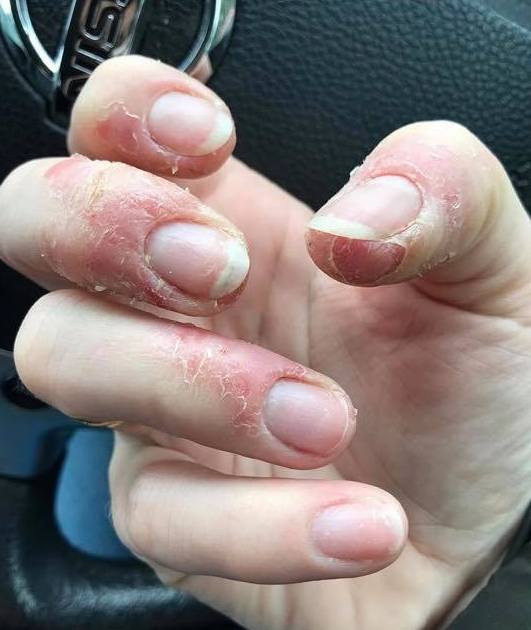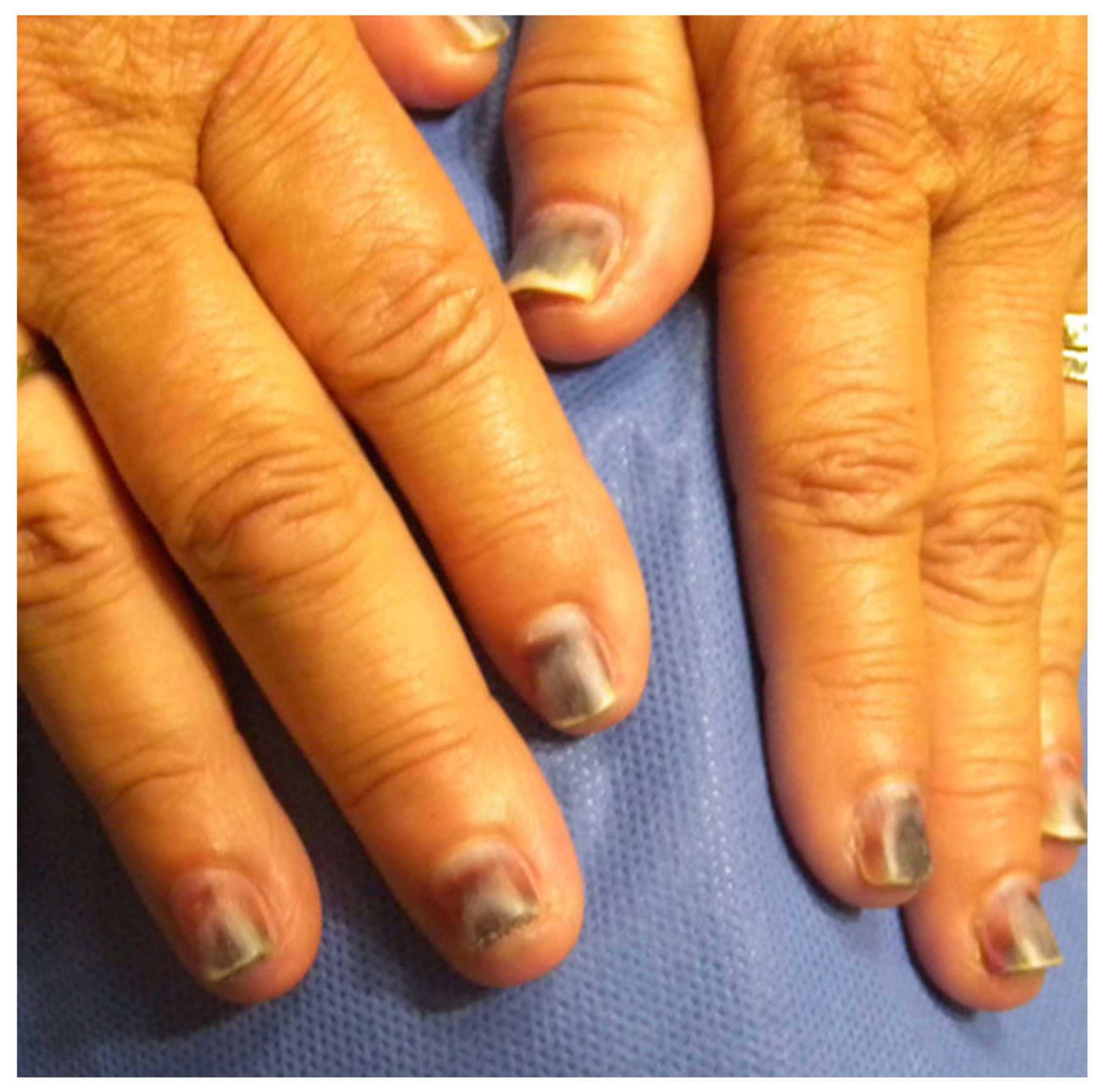Contact Dermatitis & Nail Polish: Causes, Symptoms, & Solutions
Are your perfectly manicured nails suddenly causing more harm than good? Contact dermatitis, a rash that erupts upon skin contact with a specific substance, is a growing concern for nail enthusiasts.
Contact dermatitis, in the realm of nail cosmetics, is an allergic reaction that can develop over time. This reaction is triggered by exposure to certain chemicals present in nail products. Understanding the nuances of this condition, from its causes and symptoms to effective preventive measures and treatments, is paramount for maintaining healthy, beautiful nails and skin.
Let's delve deeper into the world of contact dermatitis, specifically as it relates to the products we use to adorn our nails. Nail cosmetics encompass a wide range of products. Nail enamels (varnishes/polish), nail enamel removers, cuticle removers, and artificial nails all fall under this category. The issue often arises from sensitivity to one or more of the chemical components in these items. This can manifest as a rash, itching, and swelling, particularly around the nails.
- Aberdeen Sd Memorial Services Obituaries Schrivers Memorial
- Netspend Latest News Net Worth Insights 20242025
| Category | Details |
|---|---|
| Definition of Contact Dermatitis | A skin condition resulting from an allergic reaction to a substance upon contact. Symptoms include redness, itching, and swelling. |
| Nail Cosmetics Involved | Nail enamels (polish/varnish), nail enamel removers, cuticle removers, artificial nails (acrylic, gel), and related products. |
| Common Allergens | Acrylates, solvents (e.g., butyl acetate), colorants, shellac (in some polishes) |
| Symptoms | Redness, itching, swelling, blisters, dryness, cracking of the skin, irritation around the nail bed and surrounding skin. |
| Affected Individuals | Nail technicians, consumers of nail products, individuals with pre-existing skin sensitivities (eczema, asthma, hay fever). |
| Prevention | Patch testing, use of hypoallergenic products, proper application techniques, avoiding direct skin contact with products, using gloves when applying or removing products. |
| Treatment | Identifying and avoiding the allergen, topical corticosteroids, emollients to soothe and hydrate the skin, antihistamines (for itching). |
| Risks of Gel Nails | Nail bed damage, thinning and weakening of the natural nails, potential nail infections, nail discoloration. Prolonged UV exposure may increase skin cancer risk. |
| Related conditions | Irritant contact dermatitis: Caused by direct damage to the skin due to certain chemicals.Allergic contact dermatitis: Result of the skin reacting to the allergens contained in the products. |
Gel nails, in particular, have experienced a surge in popularity. Unfortunately, they can also be a significant trigger for contact dermatitis. The chemical components within gel polishes, such as acrylates, are often the culprits, leading to a cascade of unwanted reactions. These reactions include redness, itching, and swelling around the nails, and in more severe cases, it can extend to other areas of the body.
Consider the experience of one individual who reported developing contact dermatitis after using a gel polish for a year. The skin under their nails began to peel, accompanied by intense itching of the fingertips. This highlights a crucial point: even products that initially seem harmless can lead to allergic reactions over time. Frequent cuticle picking can also worsen the situation, compromising the skin's barrier and increasing its susceptibility to irritants.
The link between acrylic nails and contact dermatitis is well-established. The allergens found in nail cosmetics are the primary drivers of this reaction. When the skin encounters these allergens, an allergic response is triggered, culminating in contact dermatitis. This condition is identifiable through its characteristic symptoms: redness, itching, and swelling. In some cases, blisters, dryness, and cracking of the skin may also be present.
- Denzel Pauletta Washington Inside Their 40 Year Marriage
- Trevor Immelman From Masters Champ To Owgr Chair Beyond
Contact dermatitis is one of the most common allergies. It occurs when the skin develops an allergic reaction after exposure to a substance. The response can vary; some individuals might experience irritation on the fingertips, while others develop rashes on different parts of their body. This leads to discomfort from the other symptoms of the allergic reaction.
Historical context provides valuable insights. A contact allergy to acrylic artificial nails was first described in 1956 by Canizares. This underscores the enduring nature of the issue, highlighting that the problem is not new. The trend of allergic contact dermatitis related to acrylic nail products has been steadily increasing, becoming a growing concern for both nail technicians and consumers.
Shellac, a resin produced from the female lac insect, is also worth mentioning. It is commonly used in cosmetics, including nail polish, and can cause contact allergies. The allergic reactions to shellac usually manifest on the areas exposed to the product. Other cases of dermatitis associated with nail enamels include allergies to solvents like butyl acetate and nail surface discoloration, particularly around the cuticle area, caused by the colorants within the products.
Sensitivity to chemicals in nail cosmetics can lead to both allergic and irritant contact dermatitis reactions. Clinical suspicion and the interpretation of patch test results are essential, requiring a solid grasp of the chemicals used in current nail products.
Contact dermatitis often occurs immediately after exposure, as many online videos demonstrate, and is usually visible on the skin surrounding the nail or nail bed. This immediate onset emphasizes the importance of recognizing the initial signs and symptoms.
Gel nail polish (GNP) has recently gained significant popularity worldwide. Research has been conducted to provide a comprehensive summary of the complications of GNP. This research can offer valuable insights into the potential risks and adverse effects associated with the use of gel nail polish. Factors such as occupational and household exposure to wet work, and habits like thumb sucking in young children, can also impact the risk of developing contact dermatitis.
One individual shared their experience of using a gel polish and experiencing congestion. They attempted to mitigate the issue by using a fan/filter and wearing a mask, but the problem persisted. They eventually developed contact dermatitis around their eye. This demonstrates how allergic reactions can affect various parts of the body and the importance of connecting the dots between symptoms and potential triggers.
Individuals with pre-existing conditions such as asthma, eczema, and hay fever are more prone to developing irritant contact dermatitis, often with a familial tendency. While allergic contact dermatitis is not typically hereditary, understanding personal health history can aid in identifying potential risks.
In a study, a significant percentage of respondents experienced severe reactions, including skin lesions on the hands, lip swelling, or widespread skin lesions, further confirming the impact of allergic contact dermatitis. The symptoms of a gel nail polish allergy can vary, depending on individual sensitivity, and include redness, itching, swelling, blistering, and discomfort.
For those concerned about a gel nail polish allergy, it's crucial to understand the potential side effects of gel X nails, which can include nail bed damage, weakening of the natural nails, and an increased risk of nail infections. Additionally, exposure to UV light during the curing process can potentially increase the risk of skin cancer. Prolonged use may lead to nail discoloration.
The diagnosis and management of contact dermatitis require a multidisciplinary approach. Early recognition of symptoms is crucial. This starts with understanding the common allergens found in nail products and recognizing their potential to trigger reactions. Patch testing can help pinpoint the specific allergens causing the reaction. This process involves applying small amounts of potential allergens to the skin and observing for any reactions over a set period.
Once the allergen is identified, avoidance is key. This may involve choosing alternative nail products free from the offending substance or, in severe cases, avoiding nail products altogether. Protective measures, such as wearing gloves when applying or removing nail products, can help minimize exposure. Using products labeled "hypoallergenic" or "allergen-free" can be beneficial, but it's important to note that these terms aren't always strictly regulated. Always check the product's ingredients list for potential allergens.
Topical corticosteroids are often prescribed to reduce inflammation and alleviate itching. Emollients are used to moisturize and soothe the skin, helping to repair the skin barrier. Antihistamines can help manage itching, and in more severe cases, oral corticosteroids might be required. It's essential to follow the advice of a healthcare professional for treatment.
The rising prevalence of allergic contact dermatitis caused by acrylates in nail products is a growing concern. The use of acrylates, which are often found in artificial nails, has led to a rise in allergic reactions. This impacts both nail technicians and consumers, highlighting the need for increased awareness and safer product practices. This can involve choosing alternative nail products free from acrylates, and in severe cases, avoiding nail products altogether.
Alternatives for nail enhancements exist for those who react to traditional acrylic or gel products. These options include dip powder, silk wraps, and press-on nails, which may be less likely to cause allergic reactions. It's crucial to research and choose products carefully, always checking ingredients for potential allergens.
Preventive measures are critical in managing contact dermatitis related to nail products. One of the most effective measures is to avoid contact with known allergens. This means being diligent about reading product labels and avoiding products containing ingredients you know you are sensitive to. Careful application techniques can also minimize exposure. For example, avoid getting products on the skin surrounding the nail. Proper removal of nail products is equally important, as improper removal can lead to skin irritation and increased risk of allergic reactions.
The experience of an individual who developed contact dermatitis around the eye underscores the importance of identifying the source of the reaction. The dermatologist's approach of investigating rashes around the eyes offers a valuable lesson: always consider potential links to nail products and other cosmetics. If you suspect an allergic reaction, consult a dermatologist or healthcare professional. They can provide an accurate diagnosis and develop a personalized treatment plan to help you manage your symptoms and protect your skin health.
Methyl methacrylate is a substance that is used for bone cements.



Detail Author:
- Name : Estelle Bogisich
- Username : bianka.johnston
- Email : magnolia.schumm@upton.com
- Birthdate : 1978-06-15
- Address : 351 Sigrid Mount Purdystad, CA 02657-6877
- Phone : +1-856-785-6365
- Company : Padberg-Ullrich
- Job : Geologist
- Bio : Quod sint est ut cupiditate a. Corrupti tenetur at facere autem odio est ut. Sed enim eum qui eos perspiciatis magnam. Quia at quae tempora est ut repudiandae et dolor.
Socials
instagram:
- url : https://instagram.com/tanya_littel
- username : tanya_littel
- bio : Repellat quis est in ipsam nisi itaque delectus dolores. Ipsam quas alias voluptas ut.
- followers : 2415
- following : 1205
twitter:
- url : https://twitter.com/tanya.littel
- username : tanya.littel
- bio : Eum nisi dolores architecto voluptatem eos voluptatem. Eligendi est sunt rerum dolor ea. Architecto voluptatem perferendis voluptas necessitatibus at.
- followers : 5093
- following : 2856
linkedin:
- url : https://linkedin.com/in/tanya_littel
- username : tanya_littel
- bio : Totam est illum ad voluptatem mollitia sequi.
- followers : 4637
- following : 1735
tiktok:
- url : https://tiktok.com/@tlittel
- username : tlittel
- bio : Eum consectetur molestias repellendus accusantium.
- followers : 944
- following : 11